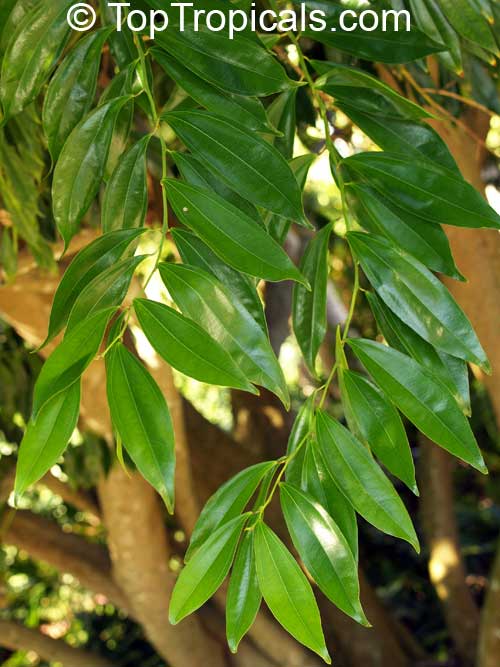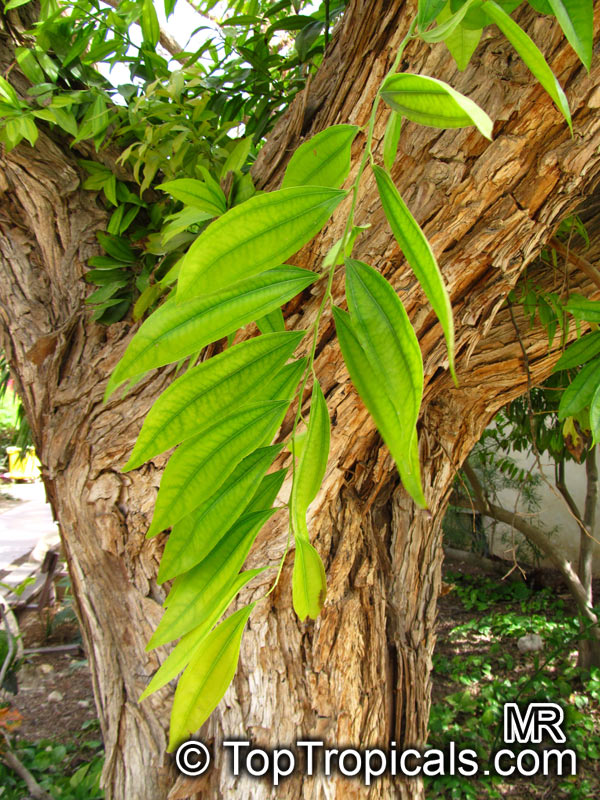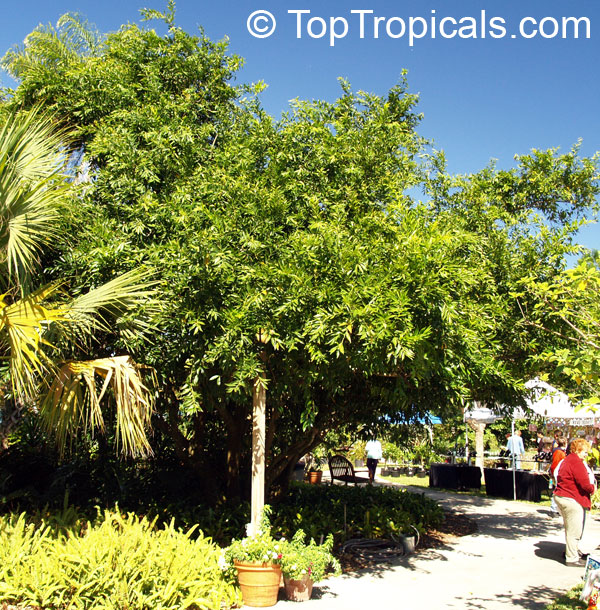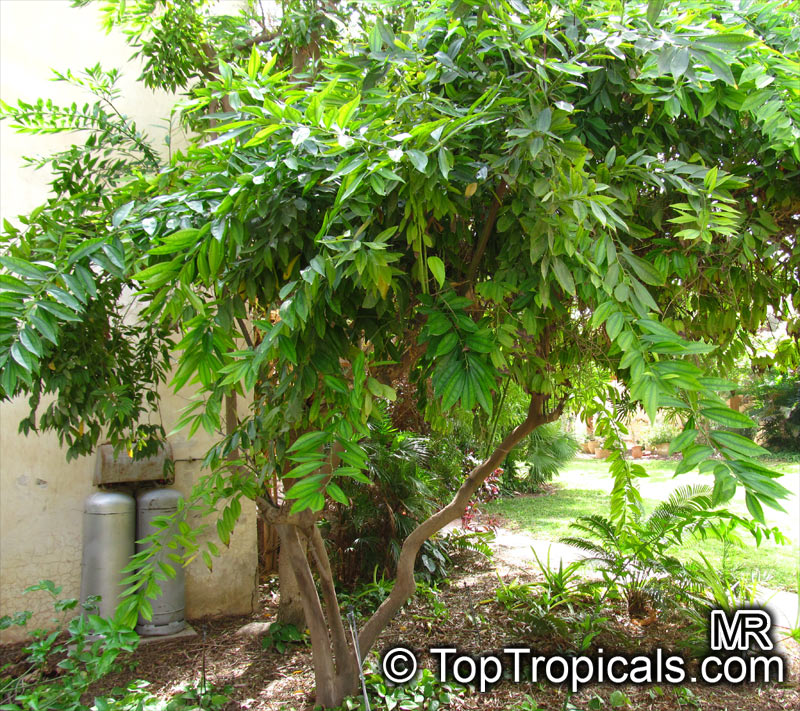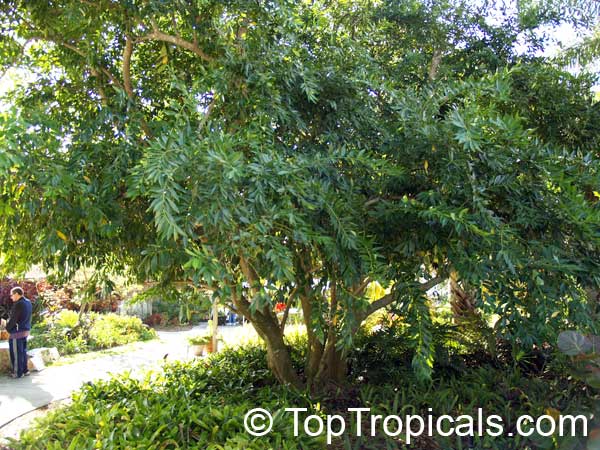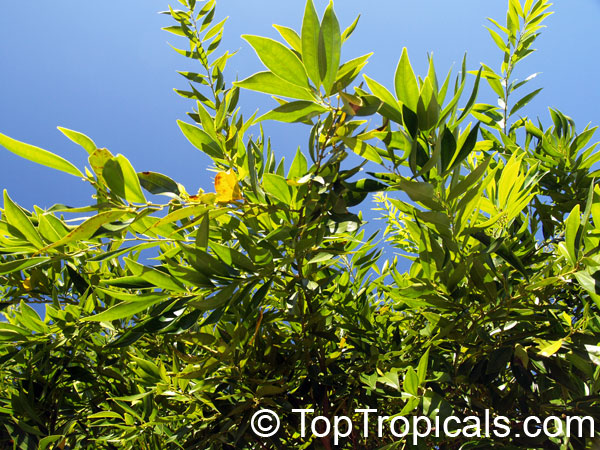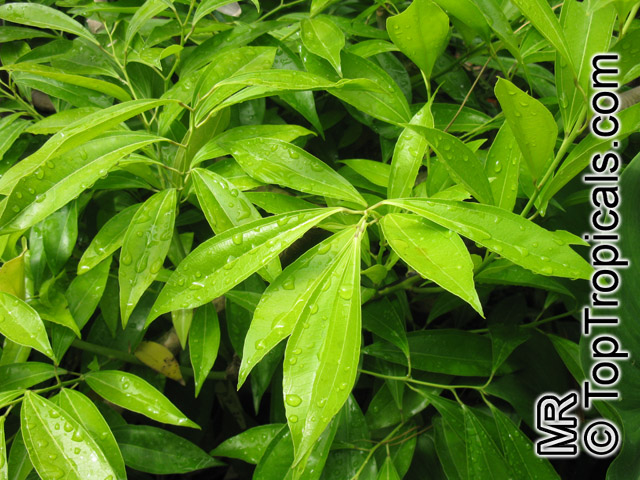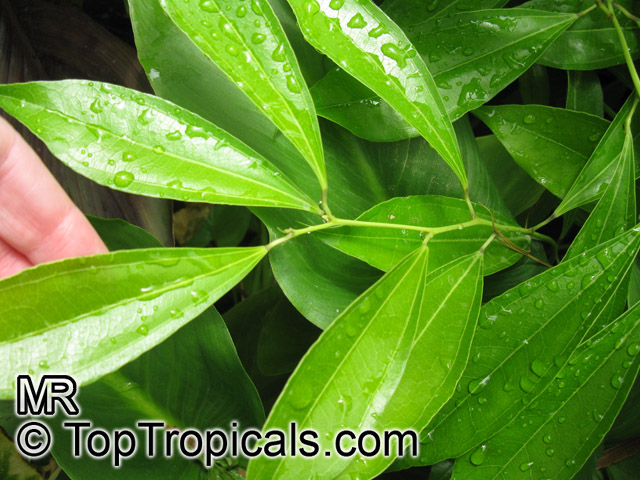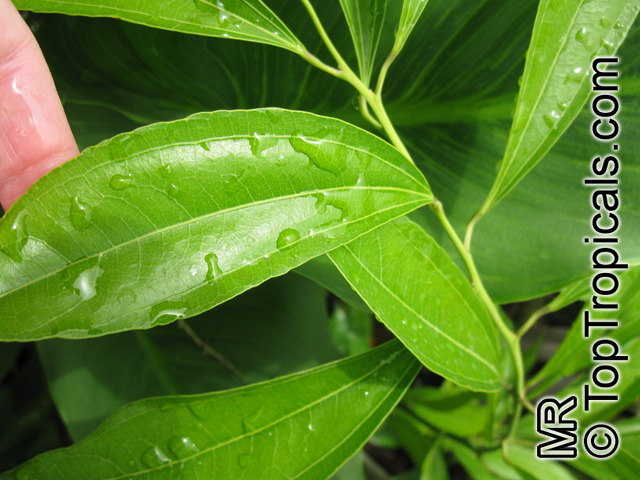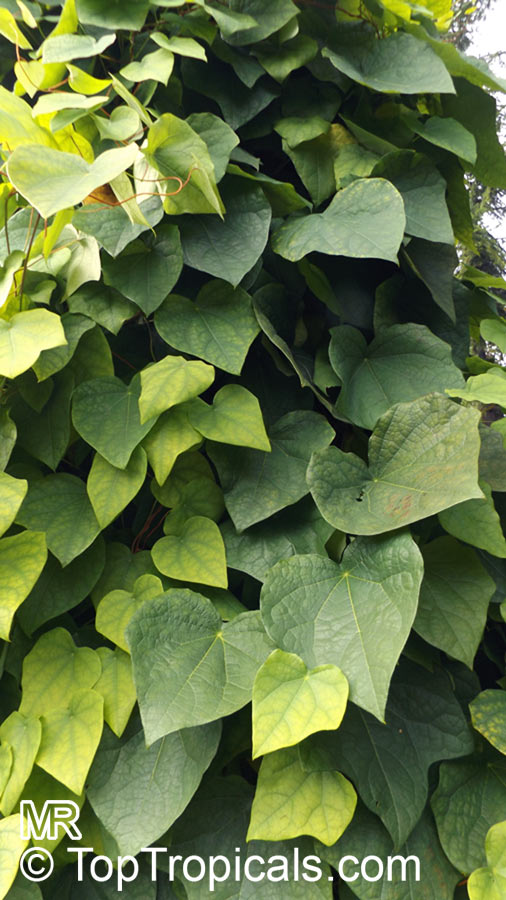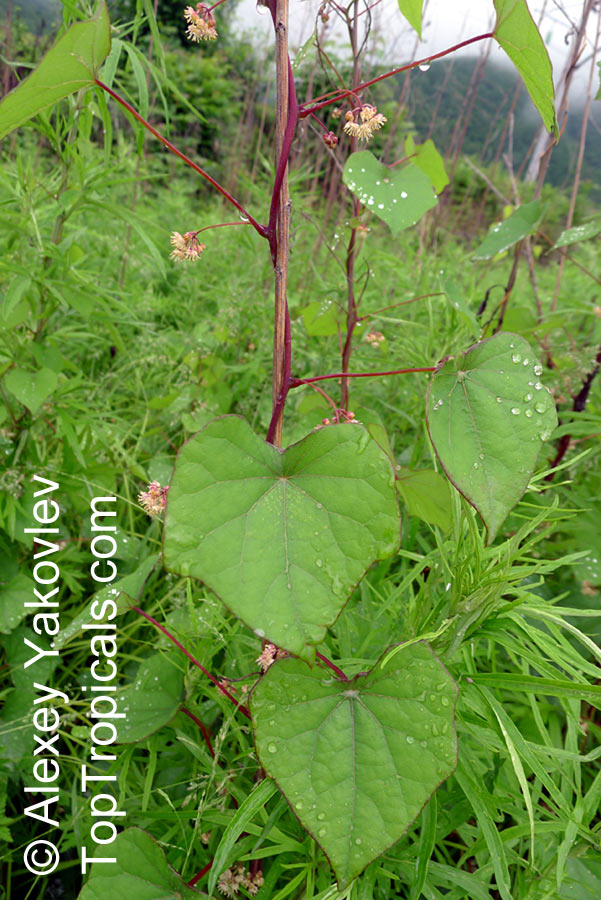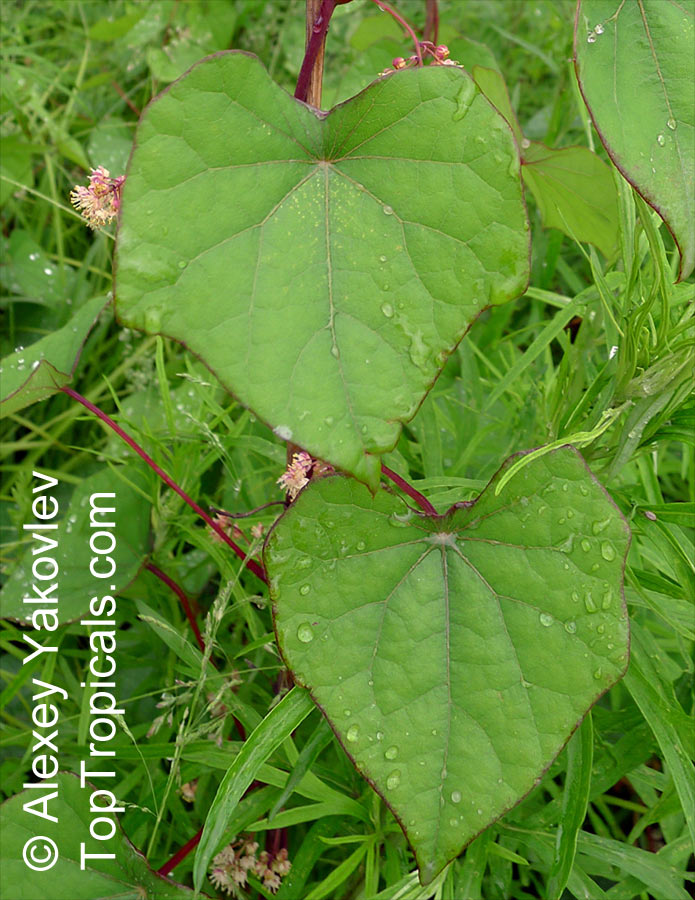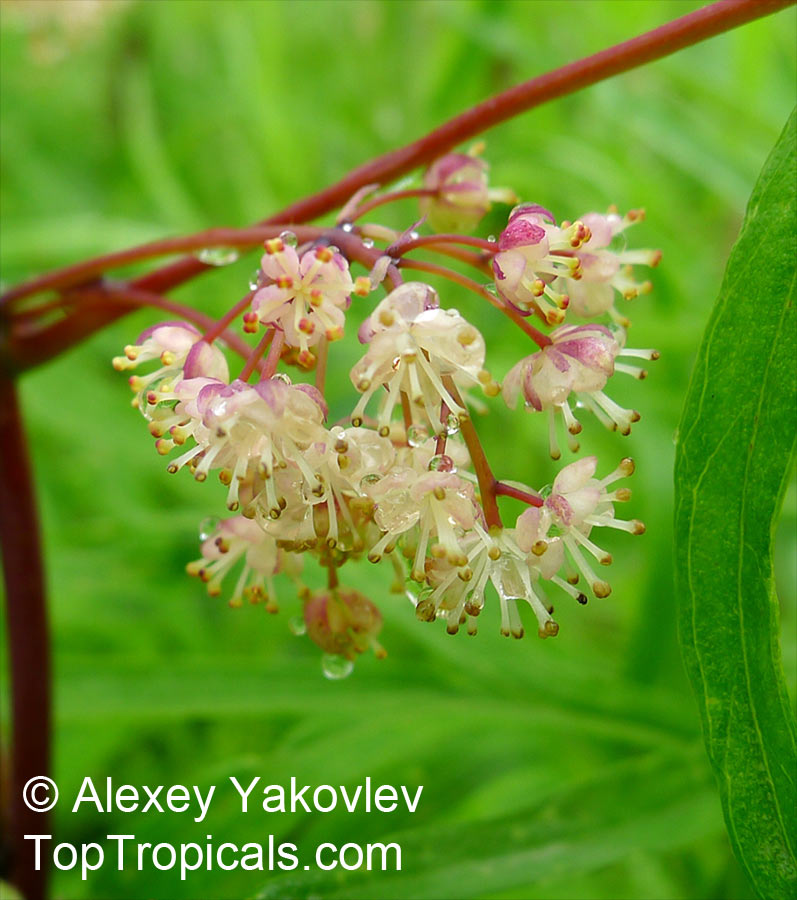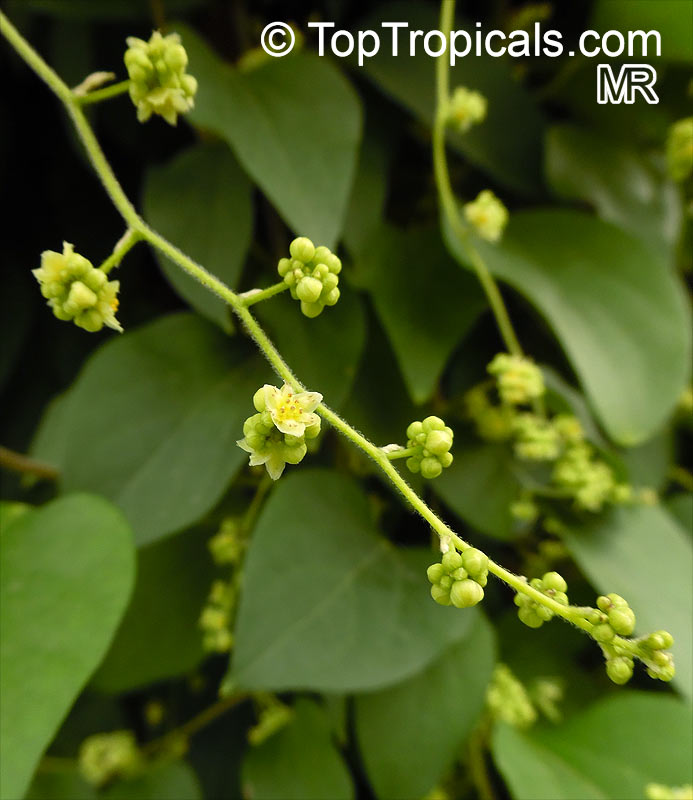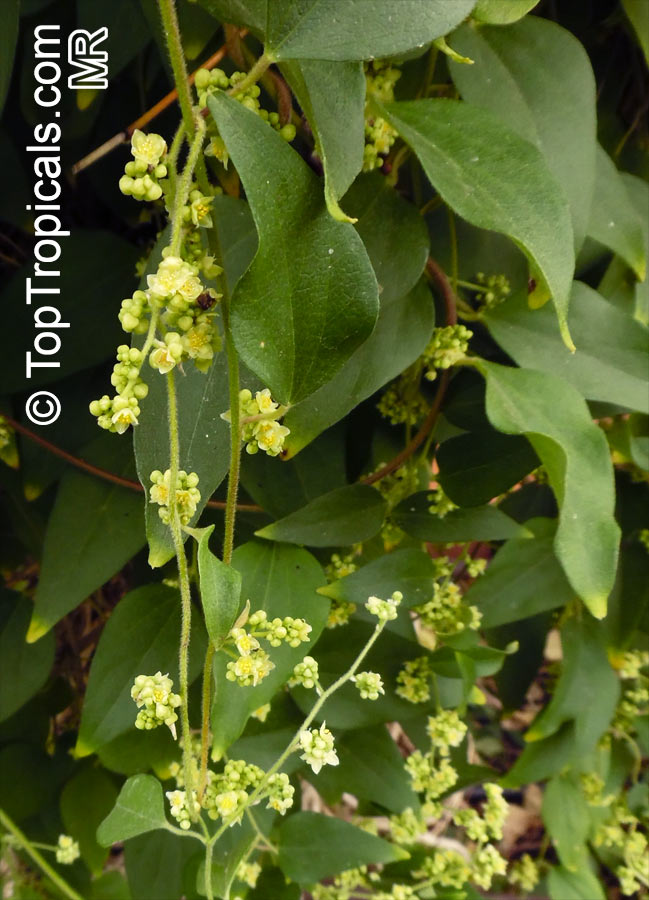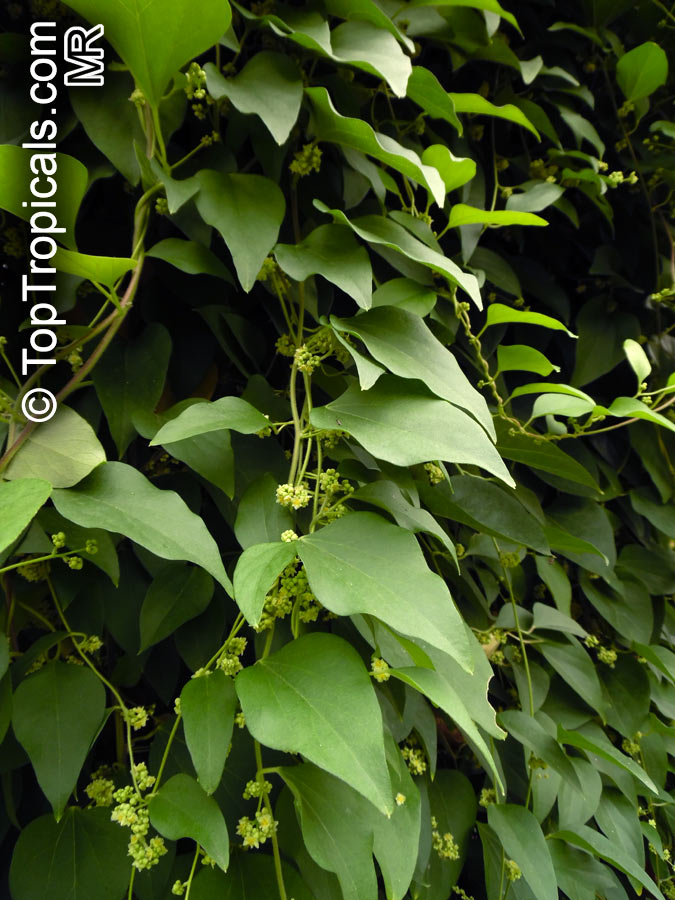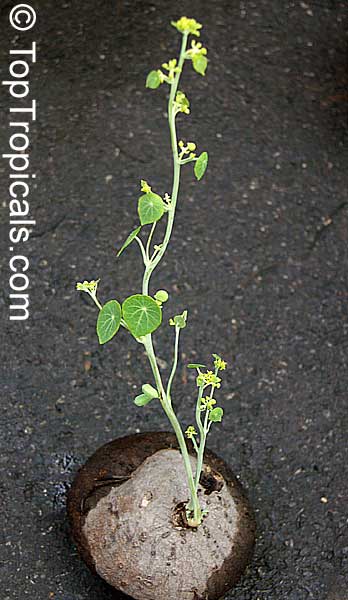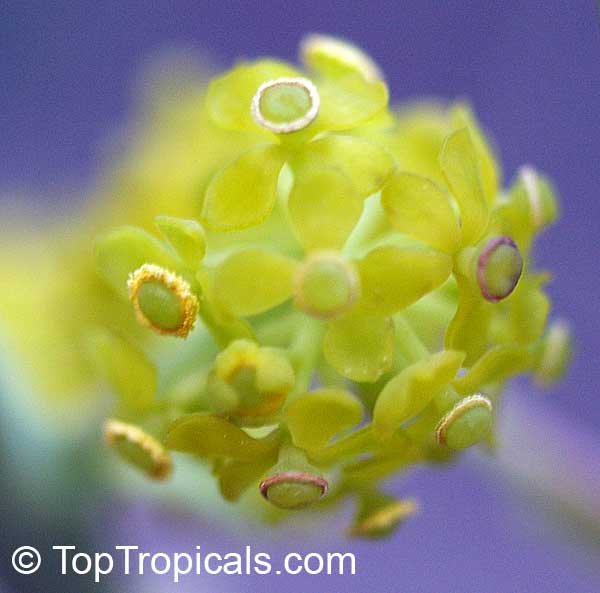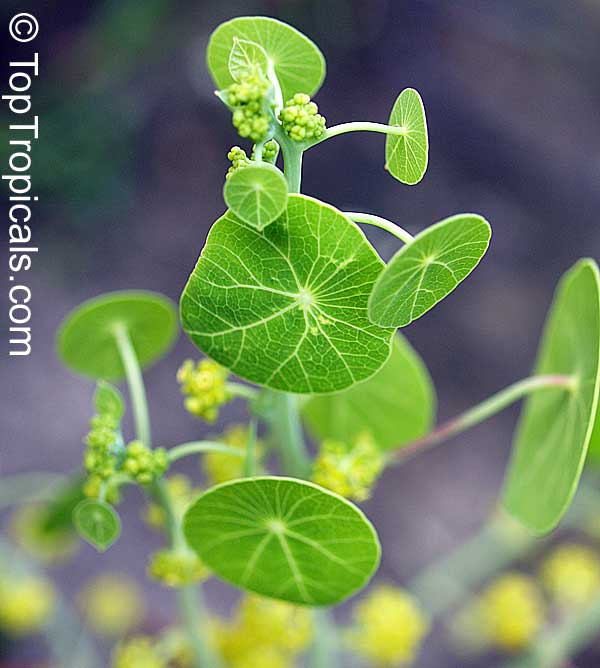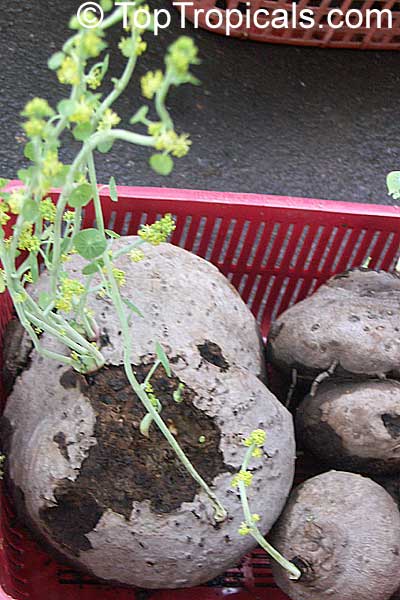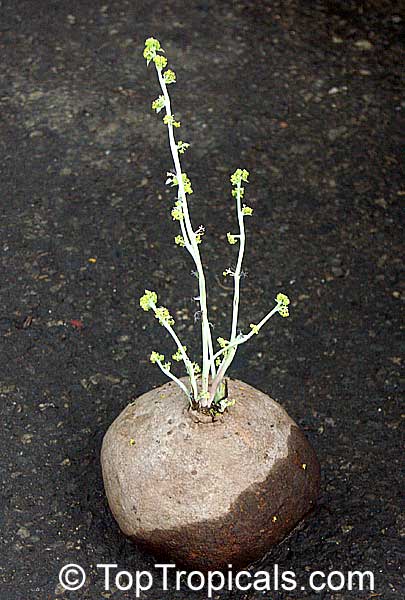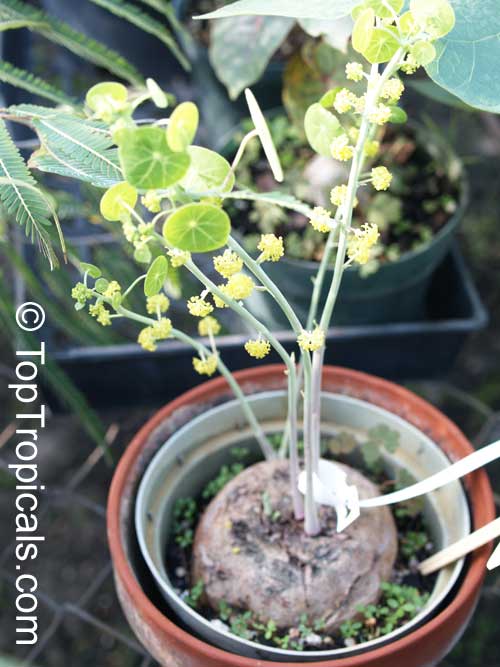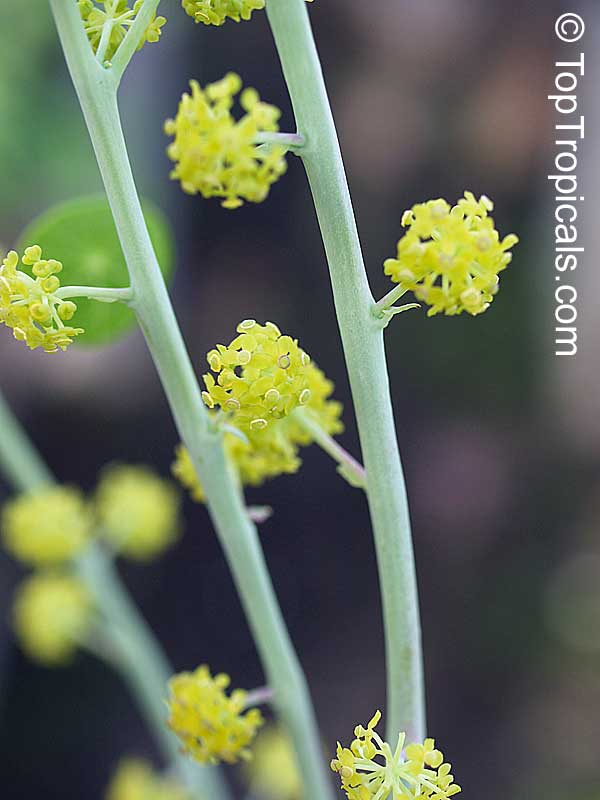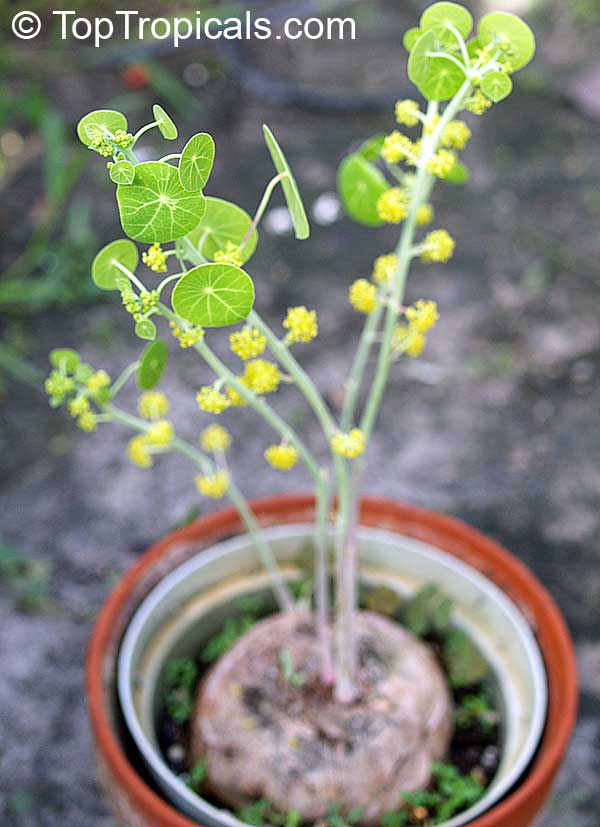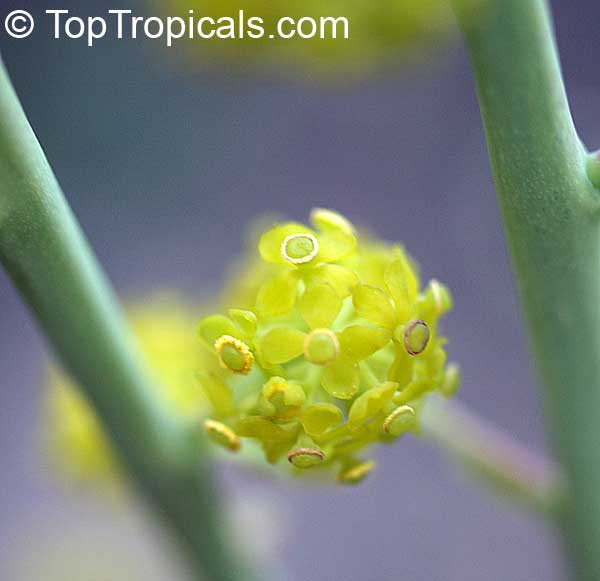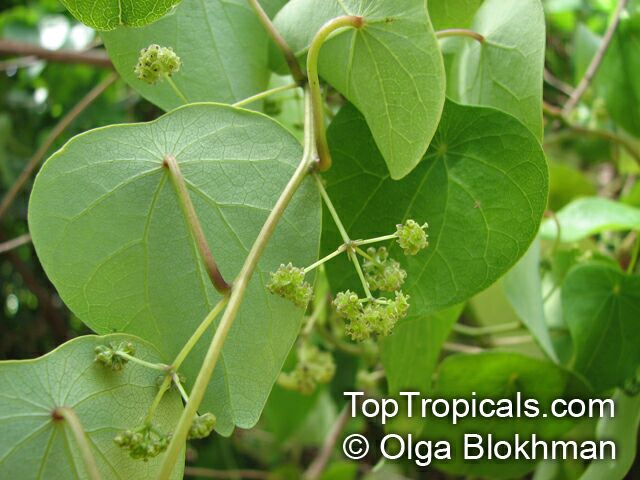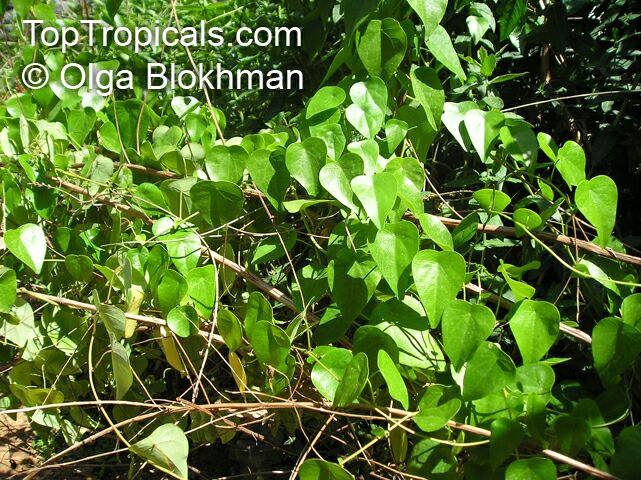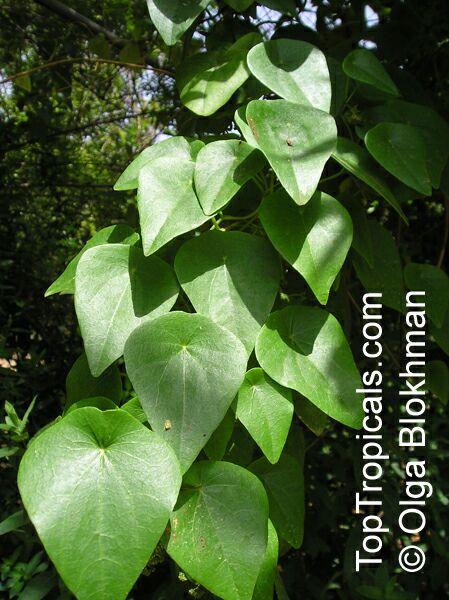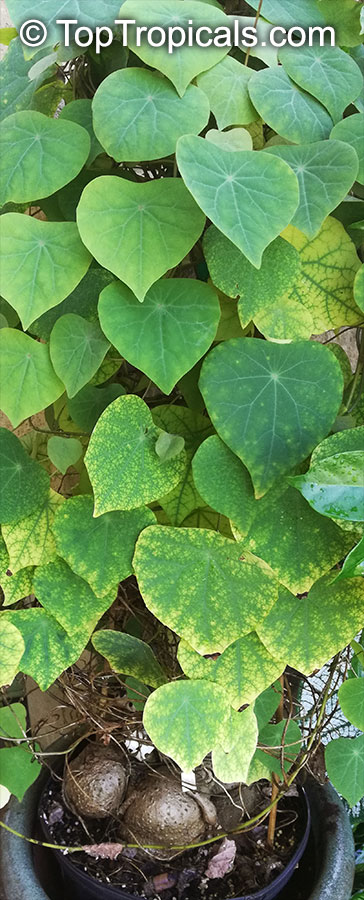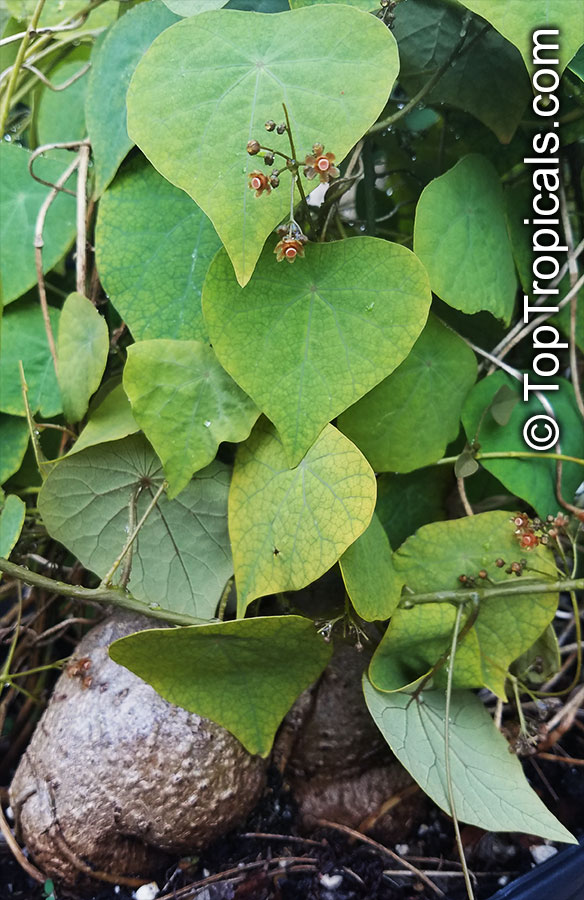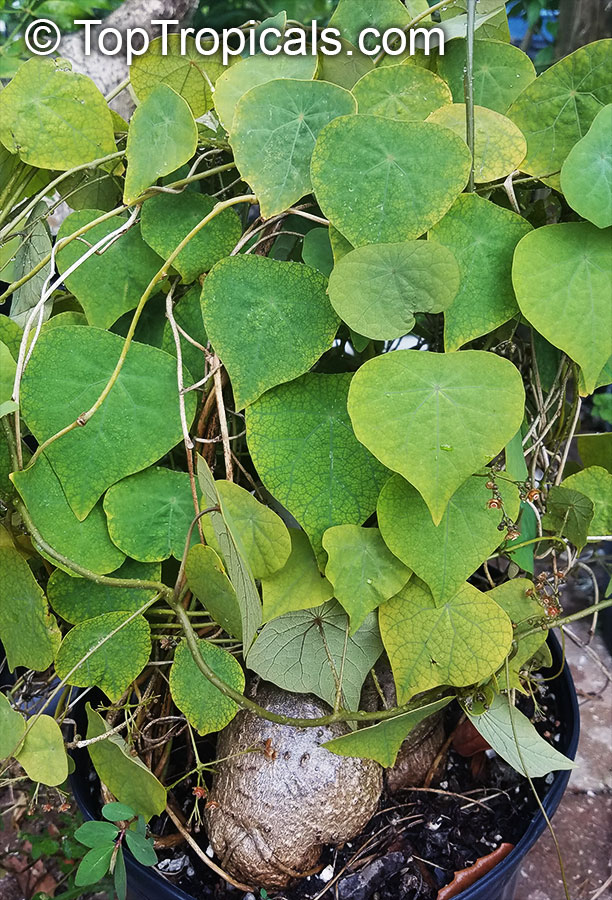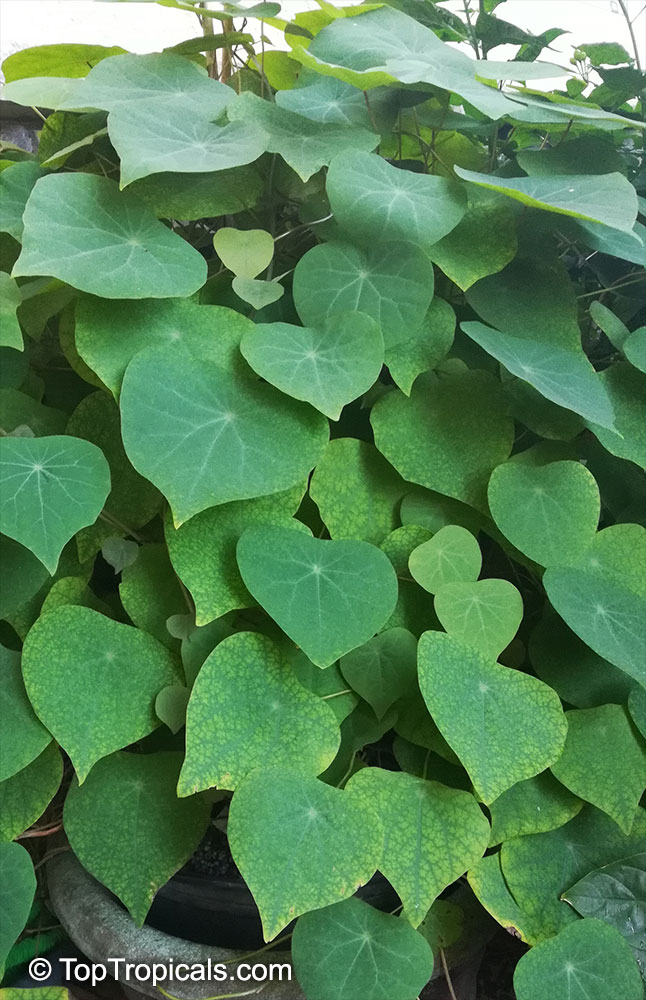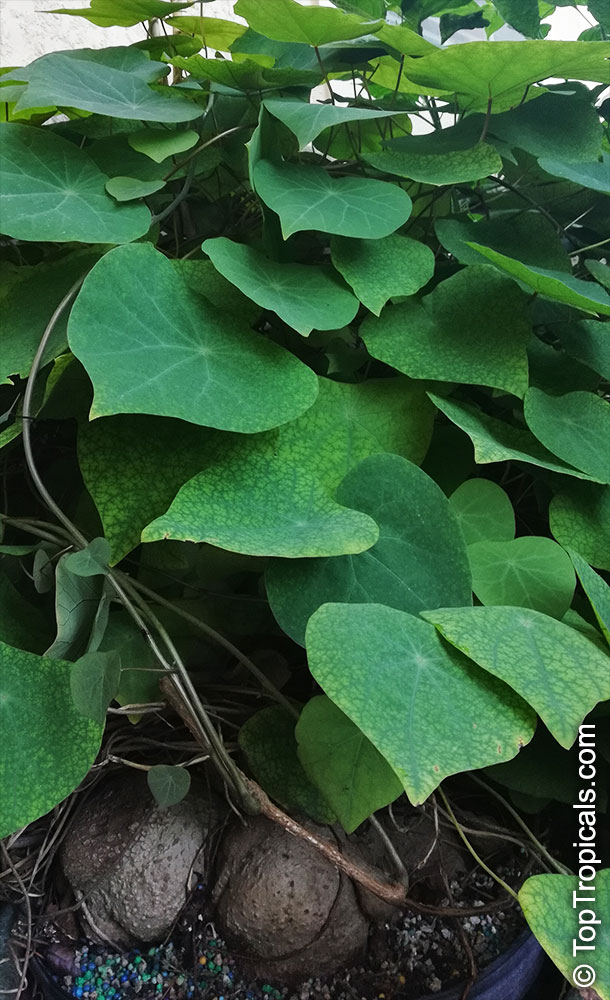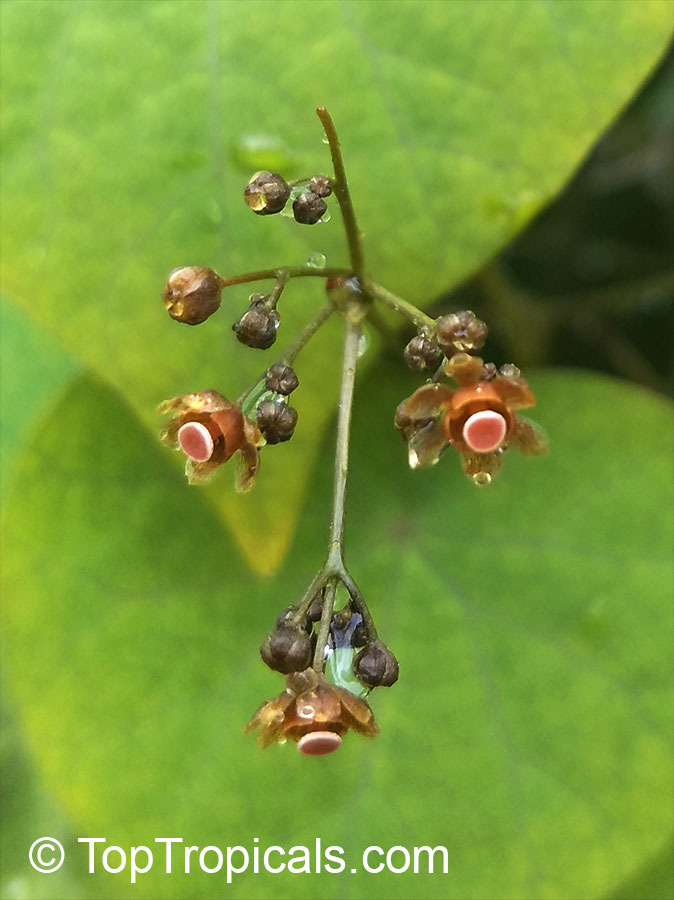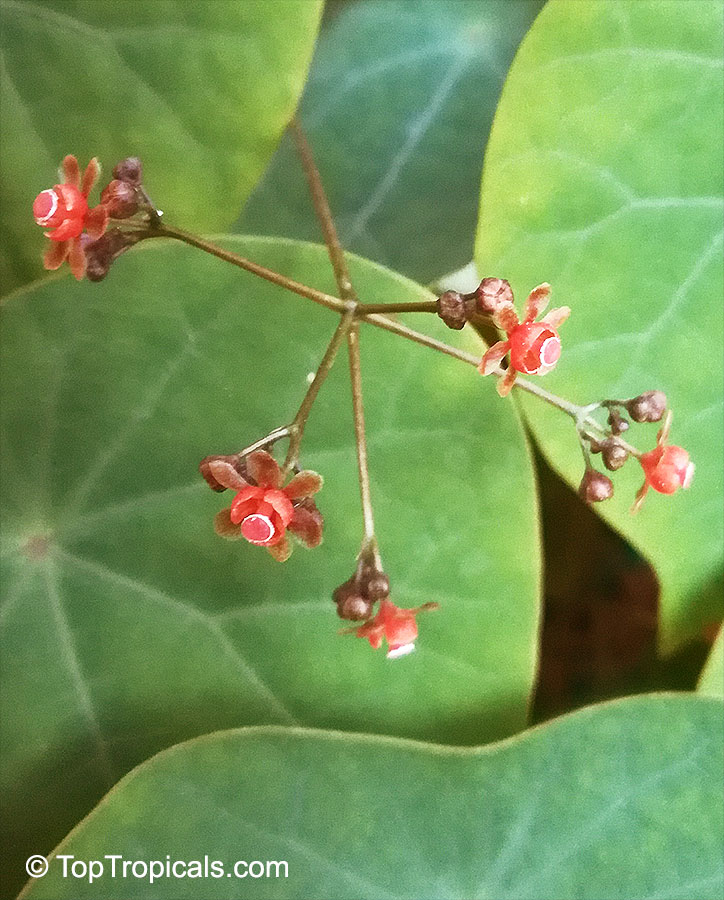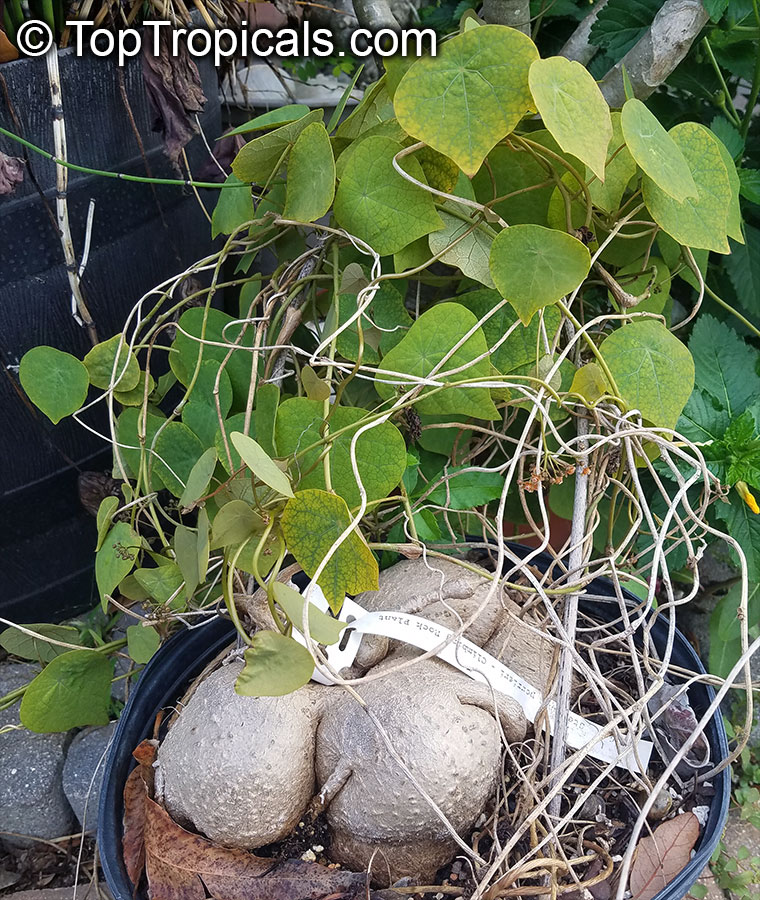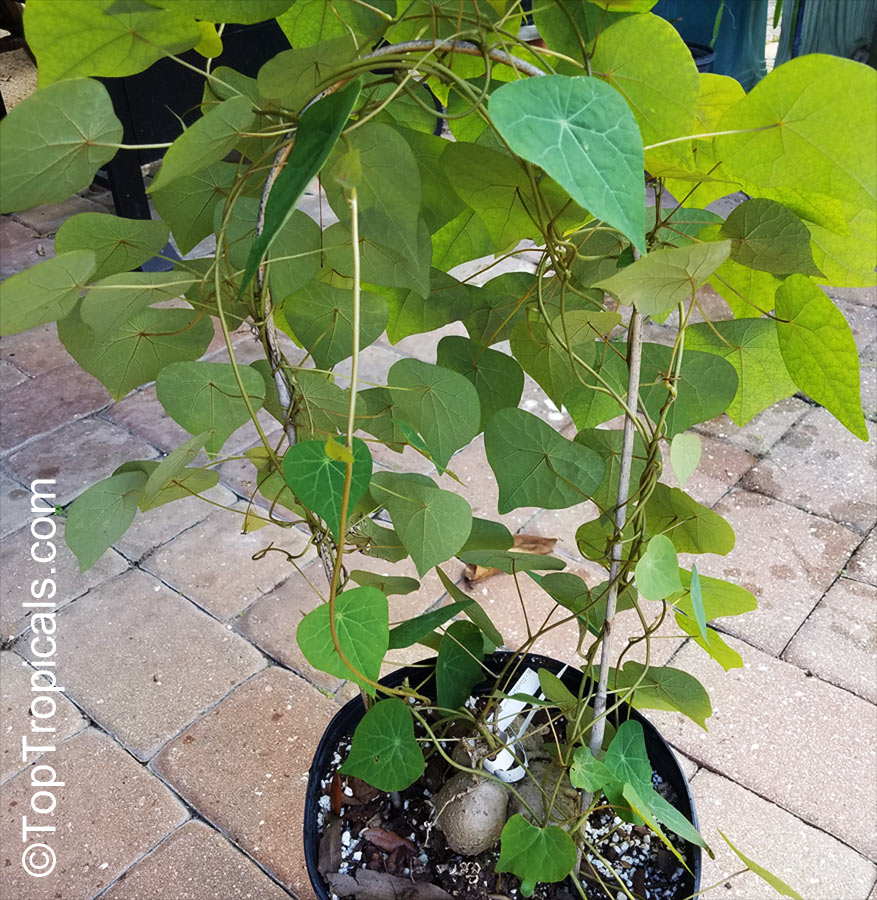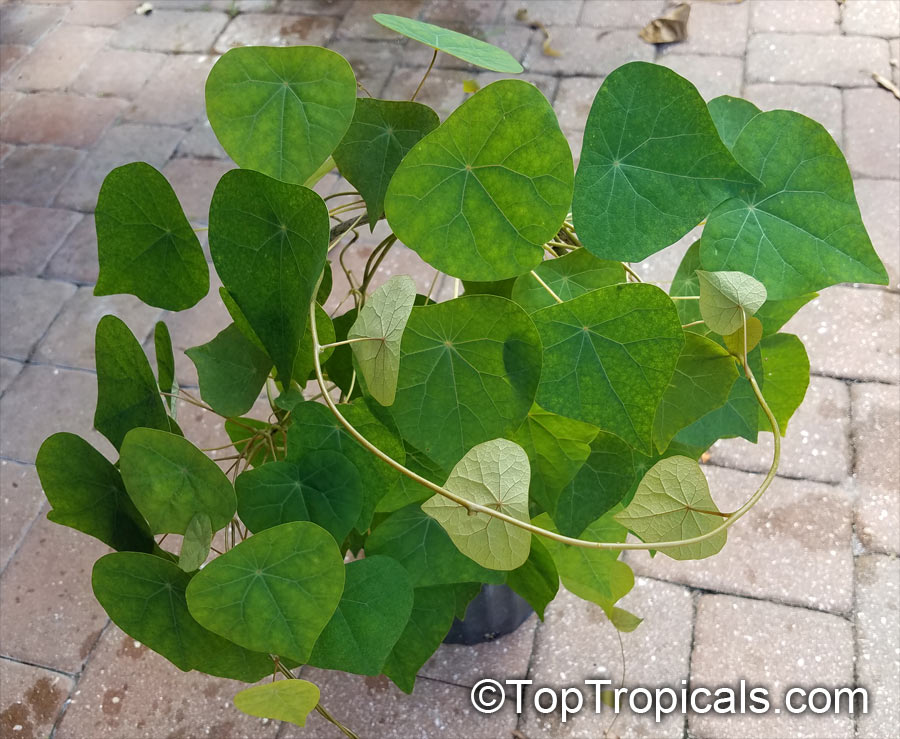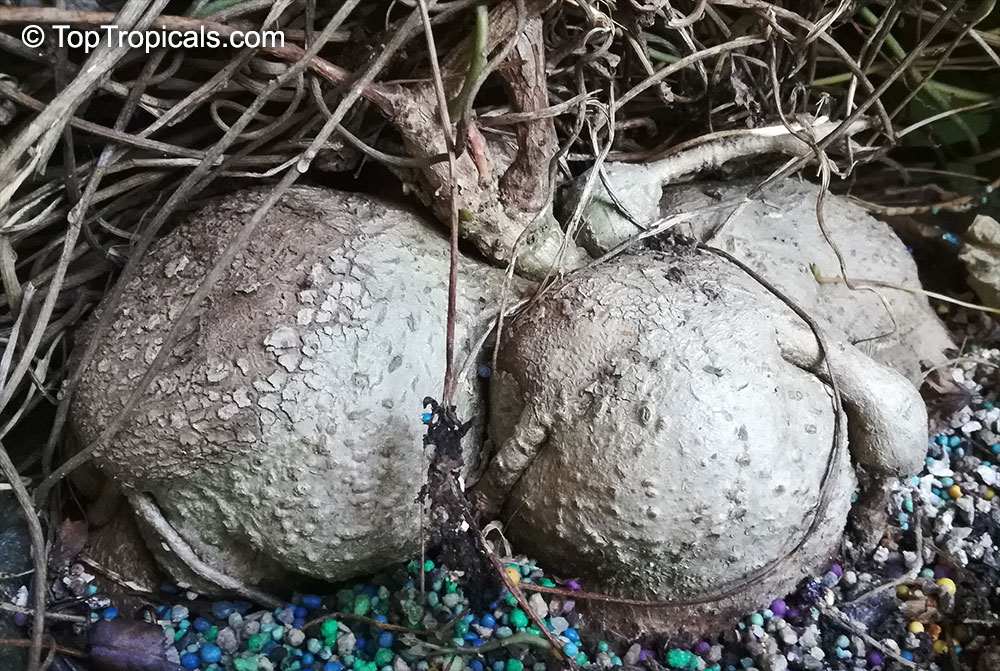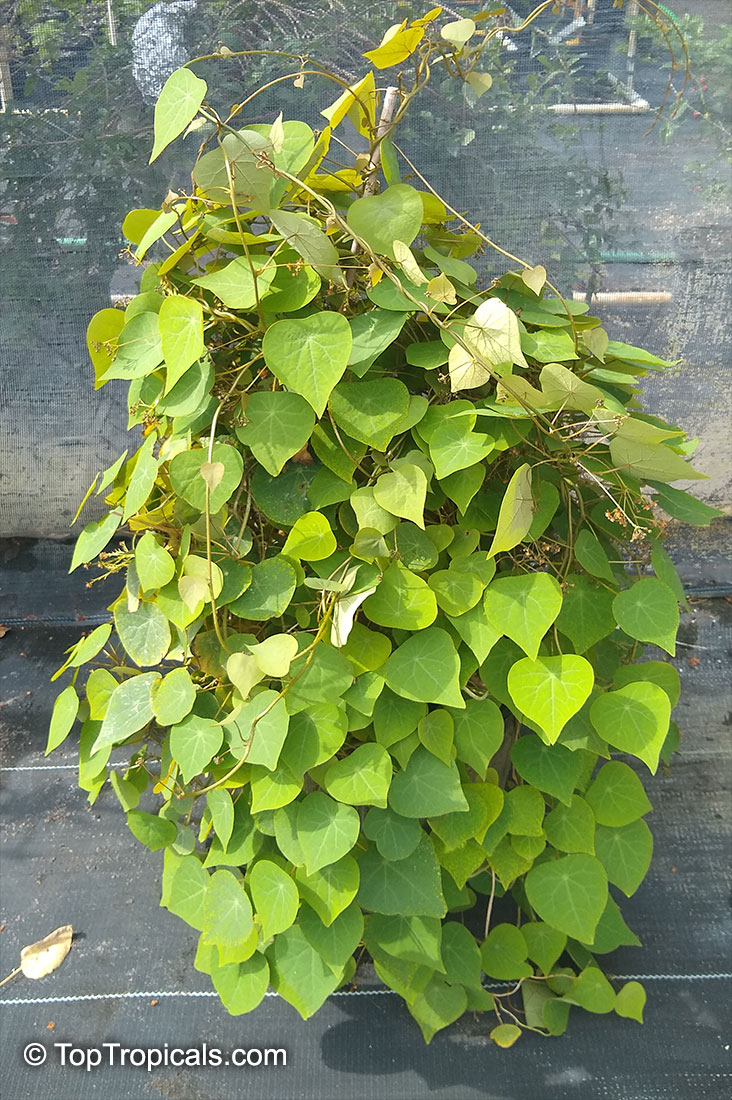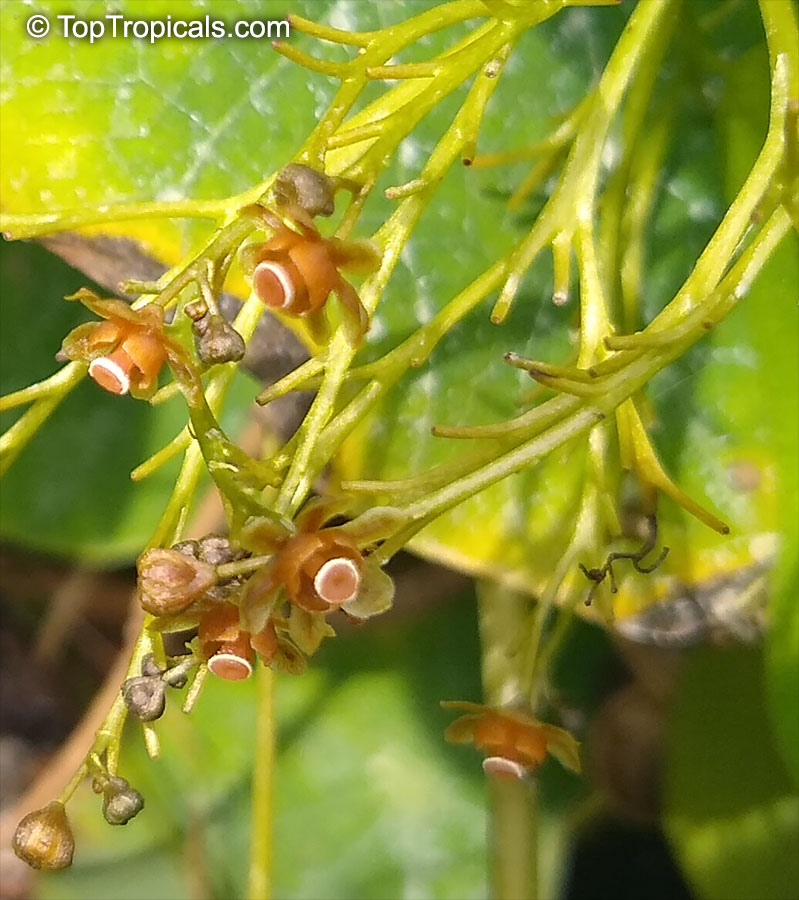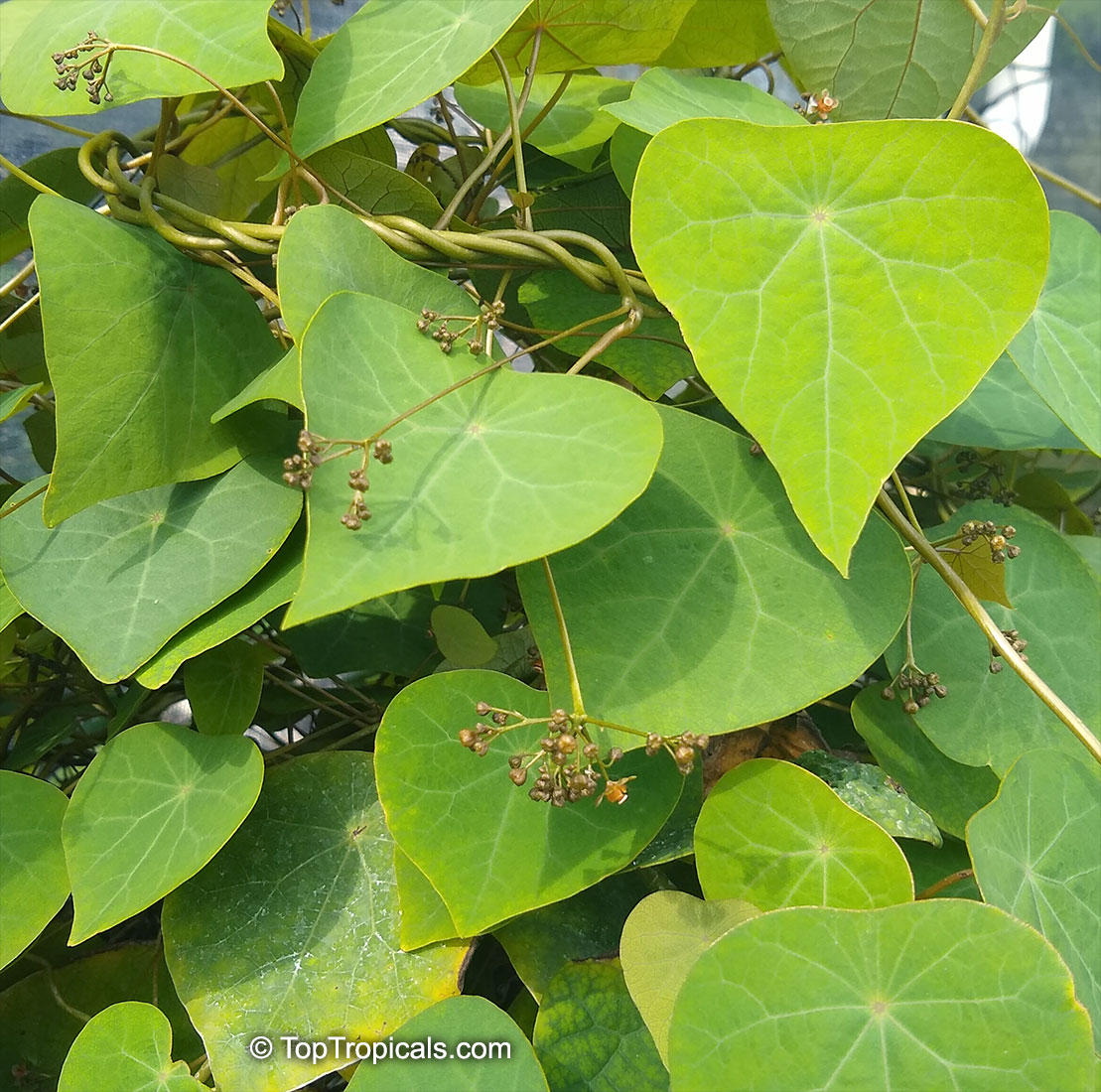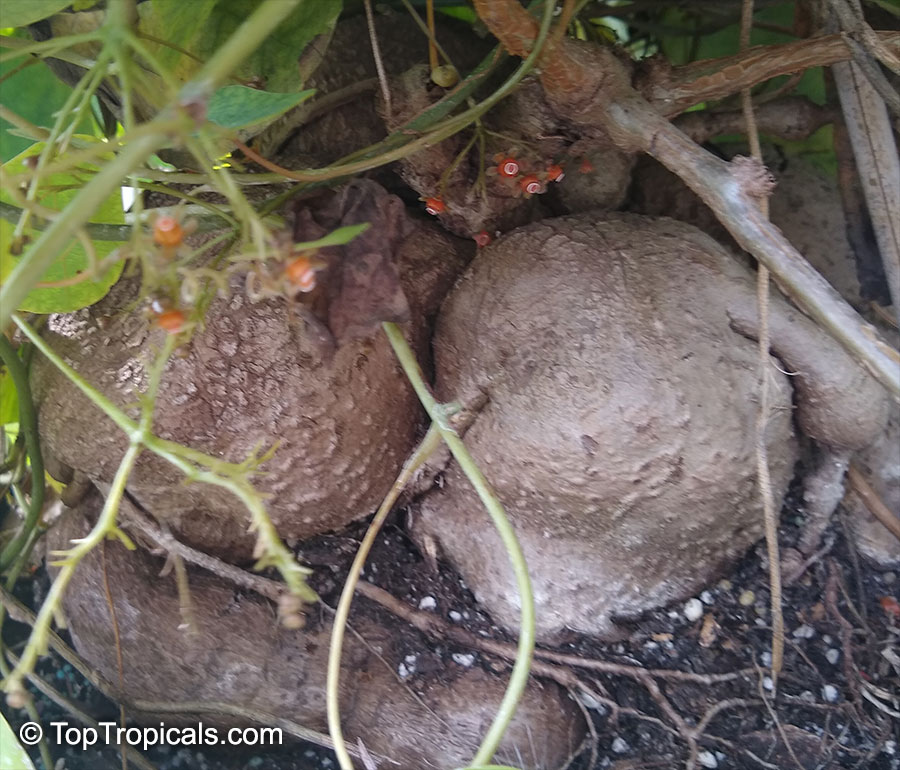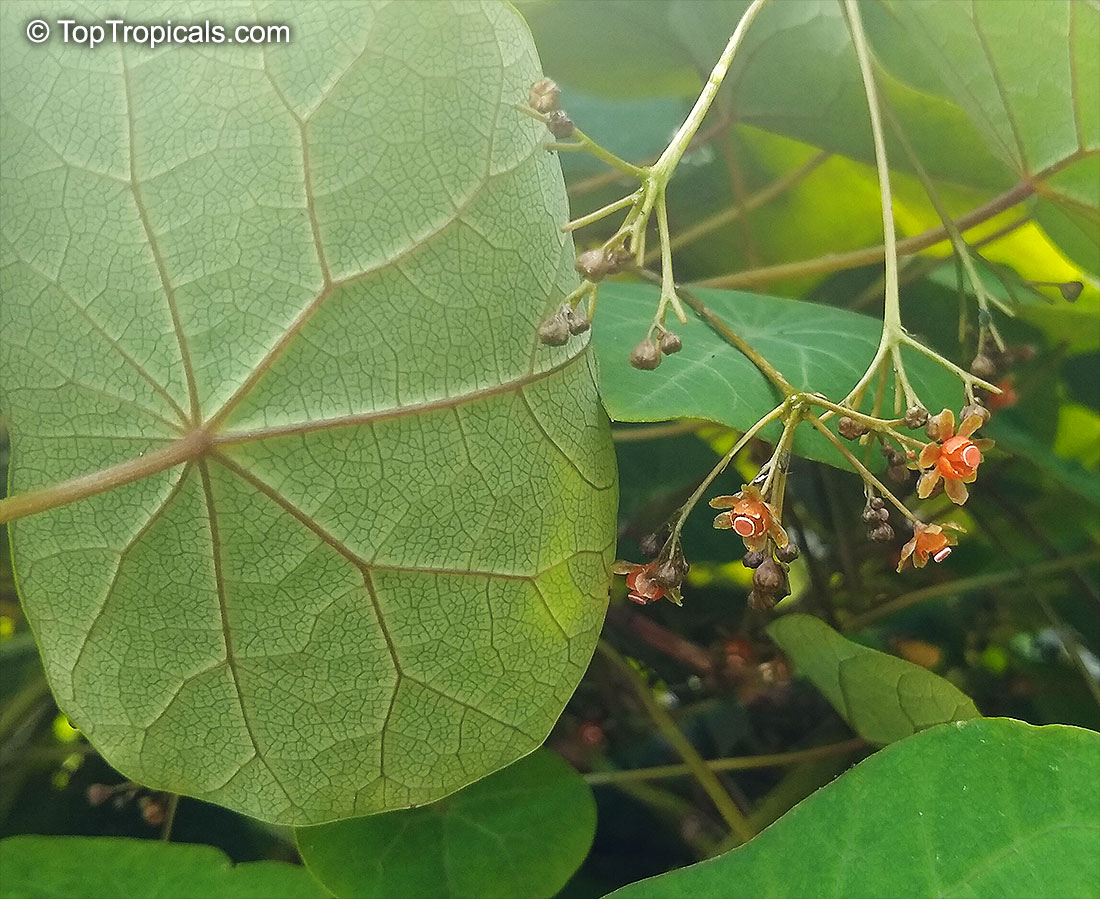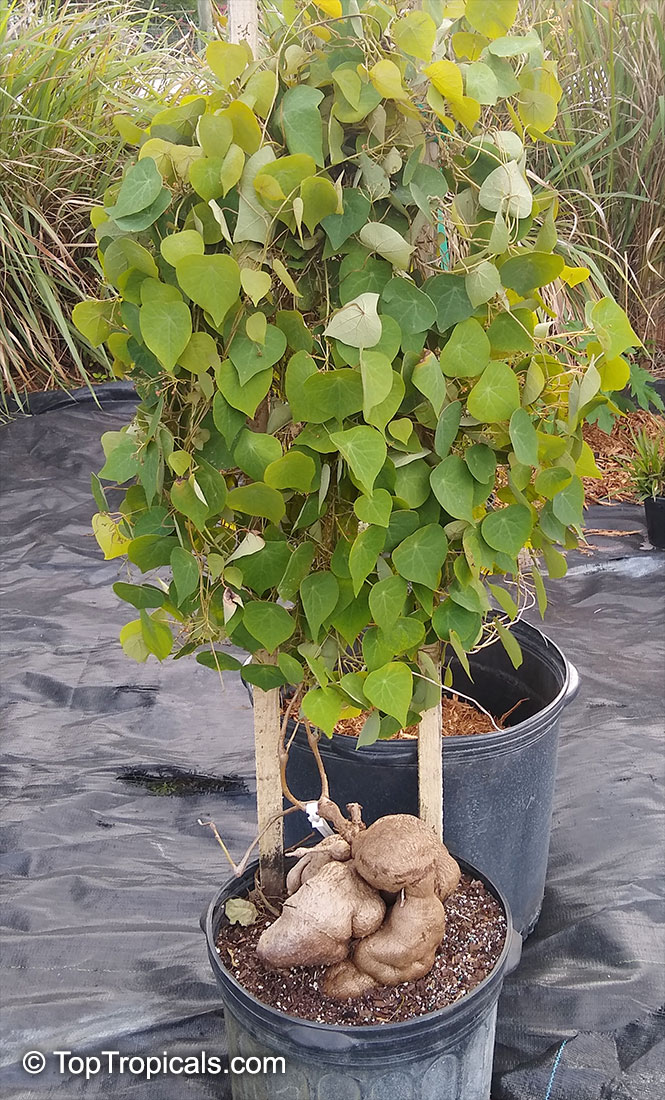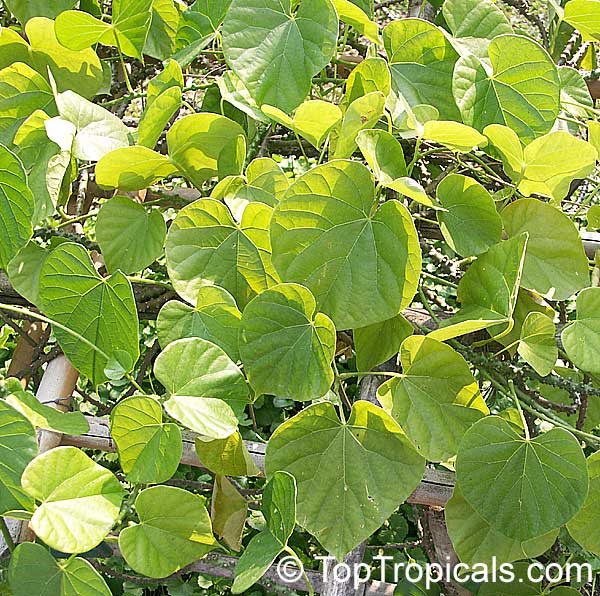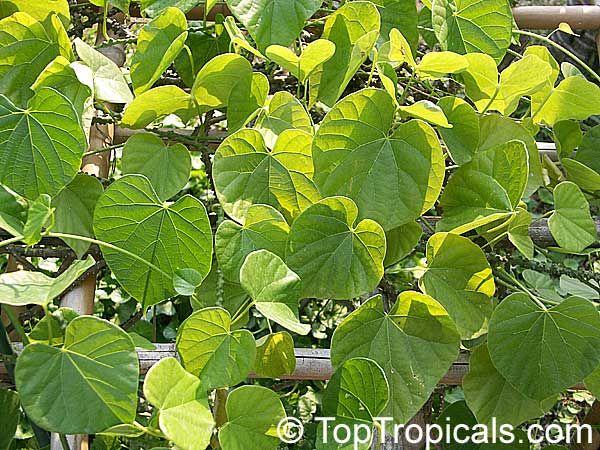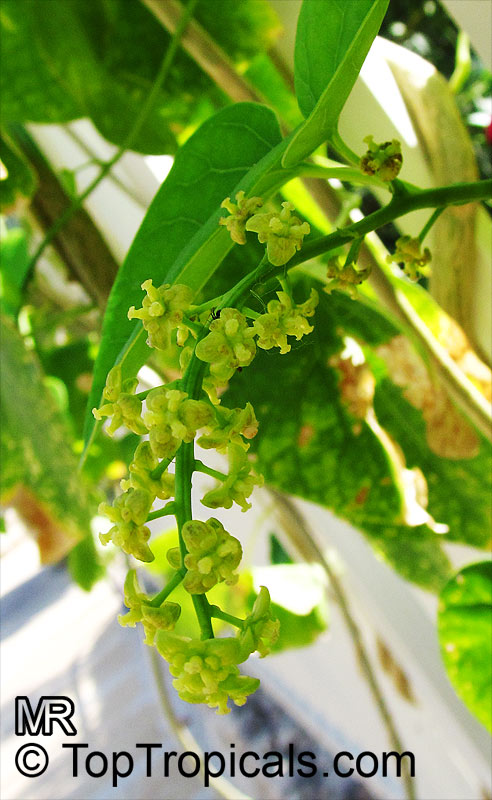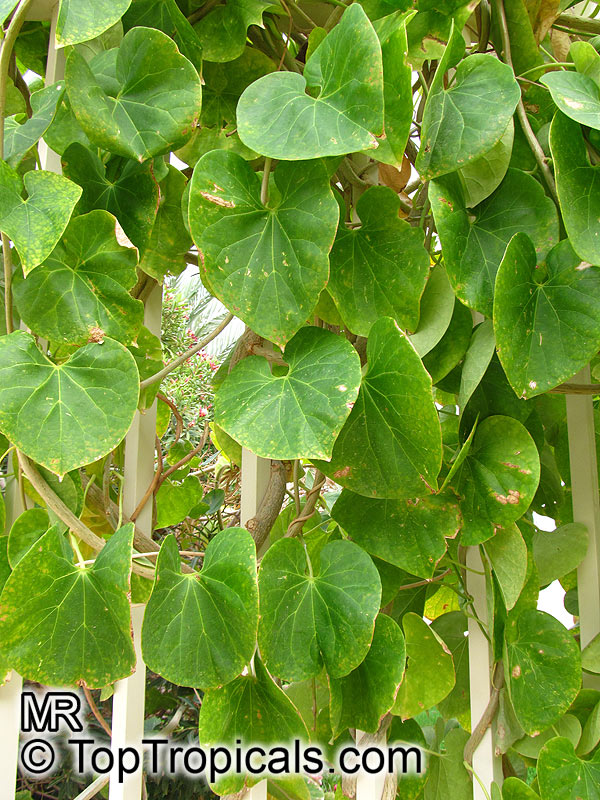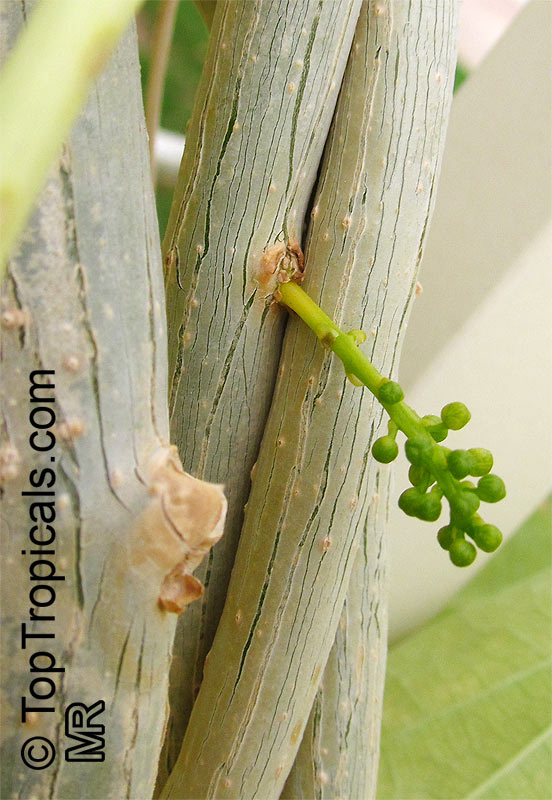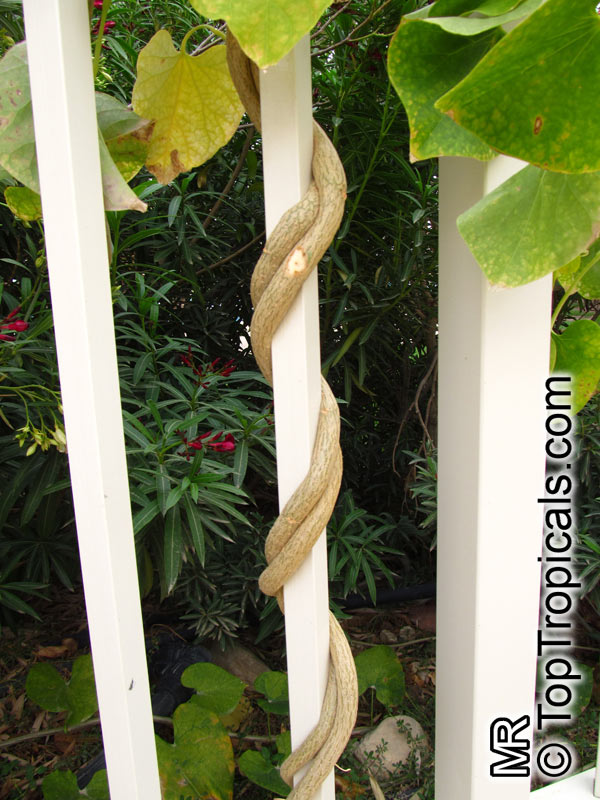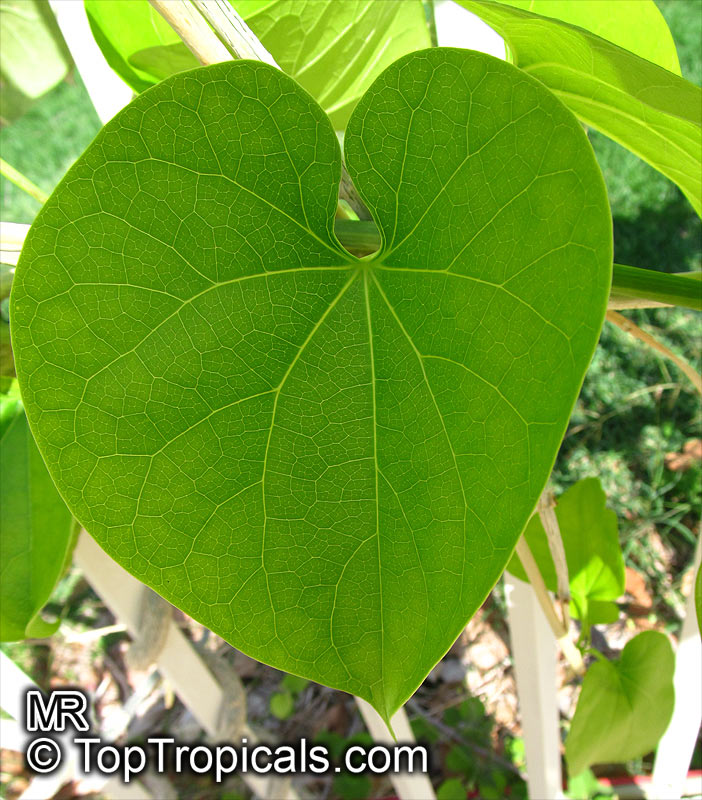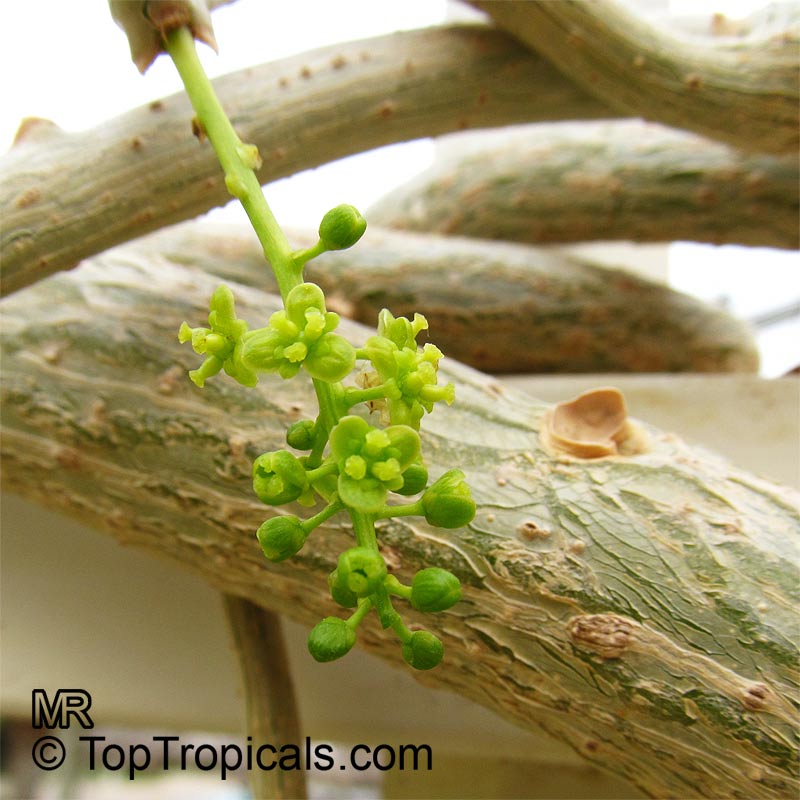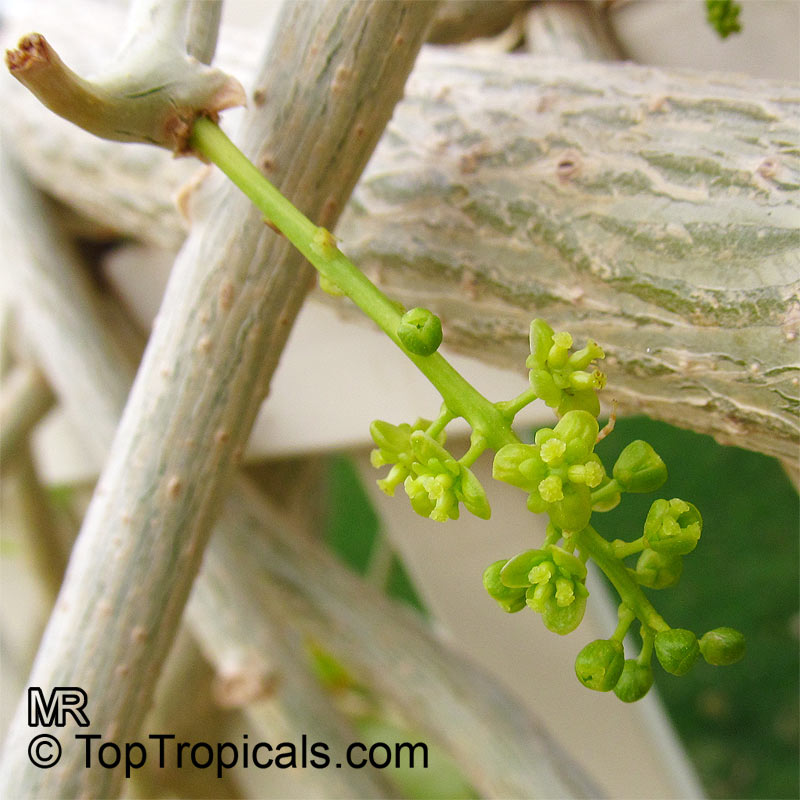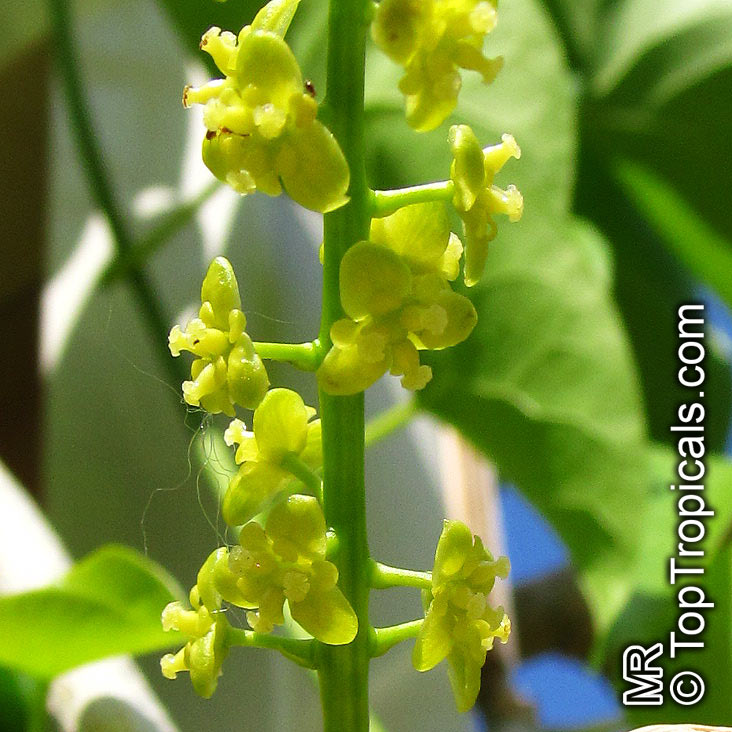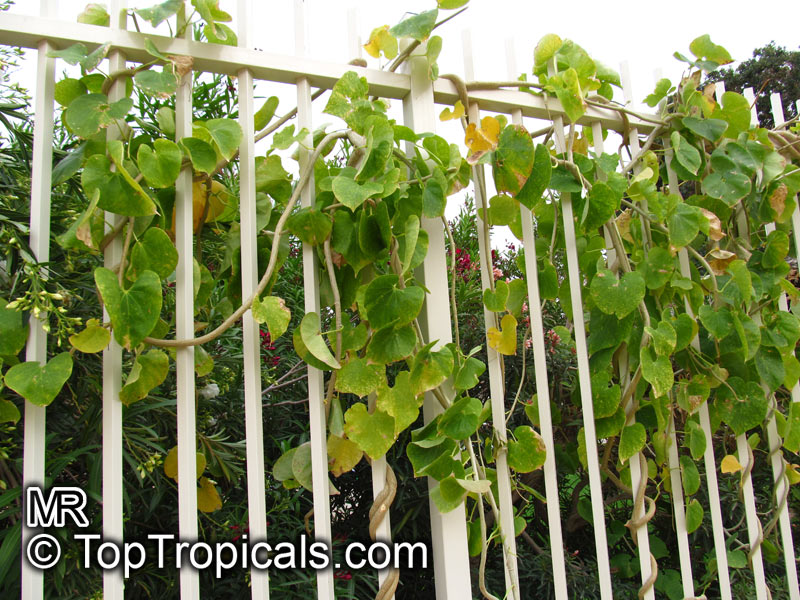Menispermaceae - Botanical Family
Top Tropicals Plant Encyclopedia
| Number of plants found: 8 |
Botanical name: Cocculus laurifolius
Common name: Laurel-leaf Snailseed
Family: Menispermaceae
Origin: South Japan to Himalayas




Cocculus laurifolius is a large ornamental shrub or small tree native to South Japan to Himalayas. It normally grows as a deciduous shrub 5-10 ft tall but can also become a small tree 10-20 ft tall. The attractive leaves are glossy, light green sometimes pale yellow when young, and become dark with age. The bark is light gray to grayish-brown and has interesting markings left by the snails that it is named after.
This plant requires full sun and moderate water. It is quite drought tolerant and can tolerate some cold weather down to at least the 30s F regionally when full grown. USDA Zone: 9-11.
When grown in a pot, care must be taken in cold regions as the containerized root system are more likely to suffer in cold temperatures. During winter, it should be moved indoors or some other protected area. Pots should have good drainage and have plenty of room for roots so that plants can grow to their full potential. It is important to keep the soil slightly moist throughout the growing season and water thoroughly once every few weeks, especially during dry summer months.
Cocculus laurifolius is an unusual and highly sought after plant in gardens and landscapes. Its attractive foliage and lack of thorns makes it an excellent choice for plantings in areas where children or other people may come in contact with it. It is also an excellent choice for topiary, as it can be easily pruned and shaped into interesting forms.
Botanical name: Menispermum dauricum
Common names: Menispermum, Moonseed
Family: Menispermaceae








Menispermum davuricum is an attractive plant with striking, large, heart-shaped leaves. Each leaf has three to five barely discernible lobes, giving the impression of a pentagon. The upper side of the leaves is covered in a glossy, dark green with visible veins, while the bottom is blue-green. In the fall, these leaves turn bright yellow. Menispermum is a creeper, and blooms with off-white, star-shaped flowers in April and May.
To ensure your Menispermum is healthy, you should plant it in full sun or partial shade and provide it with moderate water. In late winter, before new growth begins, you should perform pruning with shears or loppers with sharp, clean blades.
Menispermum has been used in traditional Chinese medicine for centuries and is believed to have medicinal properties. However, it is also a toxic plant that should be handled with caution. It's suited for growing in warm temperate climates with a USDA Zone of 9-11, although it can also be grown in cooler temperatures with the help of containers and a sheltered environment such as a south-facing balcony or wall. To grow Menispermum in a cool climate, bring the plant indoors in the winter and repot it in the spring when the warmer weather arrives. Provide a sufficient watering schedule in the summer and reduce water and sunlight in winter. Additionally, add a balanced fertilizer with low nitrogen and potassium, and a small amount of phosphorus in spring to give the plant a boost. Solutions of Euphorbia grandicornis can also be used to control weeds and keep the soil moist.
Menispermum davuricum is low-maintenance and adds exotic beauty to any home or garden. With its captivating appearance and resilient nature, you're sure to enjoy its presence.
Botanical name: Sinomenium acutum
Common name: Chinese Moonseed
Family: Menispermaceae
Origin: Eastern Asia








Sinomenium acutum is a deciduous climber growing to 6 m.
Botanical name: Stephania erecta
Common name: Stephania
Family: Menispermaceae
Origin: Thailand





Very unusual caudex plant, with a stem swollen like a round ball. Sprouts in spring in a nice fine vine with round leaves and yellowish flowers. Prefers moderate water and filtered light. Can be grown as a unique bonsai plant on your desktop or window sill. Foliage dies back in winter, when the watering should be reduced or stopped.
Botanical name: Stephania pierrei
Common name: Climbing Rock Plant
Family: Menispermaceae
Origin: Southeast Asia, Australia





Stephania pierrei , commonly referred to as Climbing Rock Plant, is native to Southeast Asia and Australia. It is a tender perennial adapted to USDA Zone: 10 and can be grown as a vine or creeper. It is a hardy, slow-growing plant that is most comfortable in regions of high humidity and temperatures ranging from 70F-85F.
Climbing Rock Plant possesses a single caudex surrounded by stems that have perennial clumping qualities. The leaves of this plant are obovate and have a pale green hue. The foliage produces long, bright green tendrils that extend outward in search of a support. In the wild, Stephania pierrei will ascend tree trunks and other networks.
When it comes to light conditions, Stephania pierrei is able to withstand full sun although in colder regions, semi-shade is preferable to ensure its longevity. Regarding water requirements, a moderate irrigation regimen is recommended.
Grown in a pot, Stephania pierrei is able to tolerate indoor cultivation from late autumn until early spring, when cooler temperatures prevail. During cold periods watering should be suspended completely. Above all, it is important to provide a well-draining pot with a soil mix that specifically suits caudex plants.
Overall, Stephania pierrei is a plant of remarkable beauty that can serve as a focal point in any garden. Its lush foliage and vigorous climbing ability make it a decorative addition to a variety of garden styles. With the proper care, this hardy permanent climber will provide brilliant garden for many years to come.
Botanical names: Tinospora crispa, Cocculus crispum, Menispermum crispum
Common name: Putarwali
Family: Menispermaceae
Origin: South East Asia






Tinospora crispa, also commonly known as Putarwali, is a unique and popular vine or creeper native to South East Asia. This plant is also known for its therapeutic properties in traditional medicine, as traditionally its aqueous extract was capable of lowering blood sugar and insulin levels. With regular care, Tinospora crispa can reach up to 2-5 ft in size and is a great addition to any garden.
Before planting, it is important to choose the right spot to ensure successful growth. Tinospora crispa thrives in full sun, and some semi-shade to ensure its best performance. It should be planted in rich, well-drained soil, and should receive regular water. The USDA hardiness zone for ideal growth is 9-11 but the plant can also be grown in a container in the colder regions.
In order to keep the plant healthy and growing, it should be provided with organic fertilizer to ensure that the soil is well nourished, and the plant is getting the right type of nutrition it needs to bloom. Also, in order to protect the plant from pests and disease, it is important to keep the soil moist and well-drained. If the soil is left too dry, it can attract different insects like aphids and mealy bugs, which can have an adverse effect on the overall health of the plant.
When growing Tinospora crispa in colder climates, it is important to provide protection, either through a greenhouse or a heated plant cover. The cover should be designed to ensure that the plant is able to maintain a temperature that is high enough for it to continue to thrive.
Tinospora crispa is a unique plant with both ethnomedical and aesthetic appeal. Its traditional medicinal qualities make it a must-have in any garden or landscape, and with proper care, it will a beautiful addition to any outdoor space.
Botanical name: Tinospora sp.
Common name: Tinospora
Family: Menispermaceae
Origin: Africa, Asia








Tinospora is a genus of approximately 30 species distributed Africa, Madagascar, Asia to Australia and the Pacific Islands.
Tinospora sp. is a vine producing unusual yellow and orange flowers, followed by small fruits, which make this species a very striking addition to any garden.
It grows well in full sun or semi-shade and needs to be planted in well-drained, moist soil. It requires moderate water but can suffer from too much water. The plant is best grown in USDA Zone 9-11.
In areas with cold temperatures, the Tinospora plant should be grown in a pot and brought inside during winter to protect it from strong winds and other adverse weather conditions.
In addition to growing this species in your garden, it can also be grown in a hanging basket and trained along a trellis to create a striking feature. When it comes to caring for Tinospora, you should prune back any dead foliage and fading flowers to help promote new growth and blooms.
Overall, the Tinospora is a great addition to any garden. Its unusual color, yellow and orange flowers, and ethnomedical properties, makes it an interesting and attractive species that can thrive in your garden with the right care.
Use link to repeat this search:
https://toptropicals.com/cgi-bin/garden_catalog/cat.cgi?search_op=and&keyword_op=and&language=e&family=Menispermaceae
&number=10&no_change_lang=1&user=tt&sale=1&first=0
